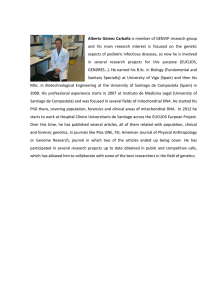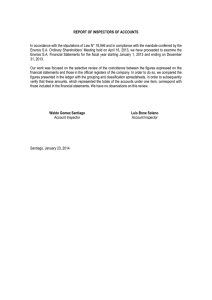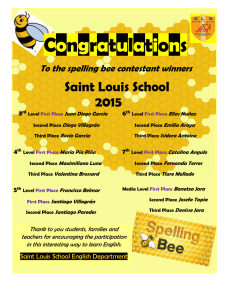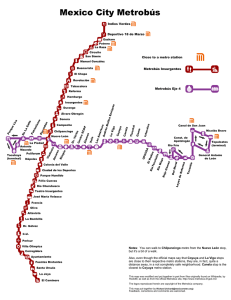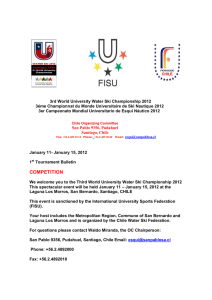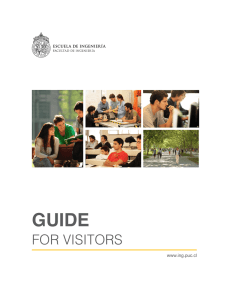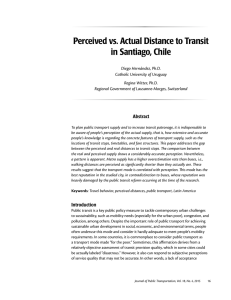survival guide - Universidad de los Andes
Anuncio
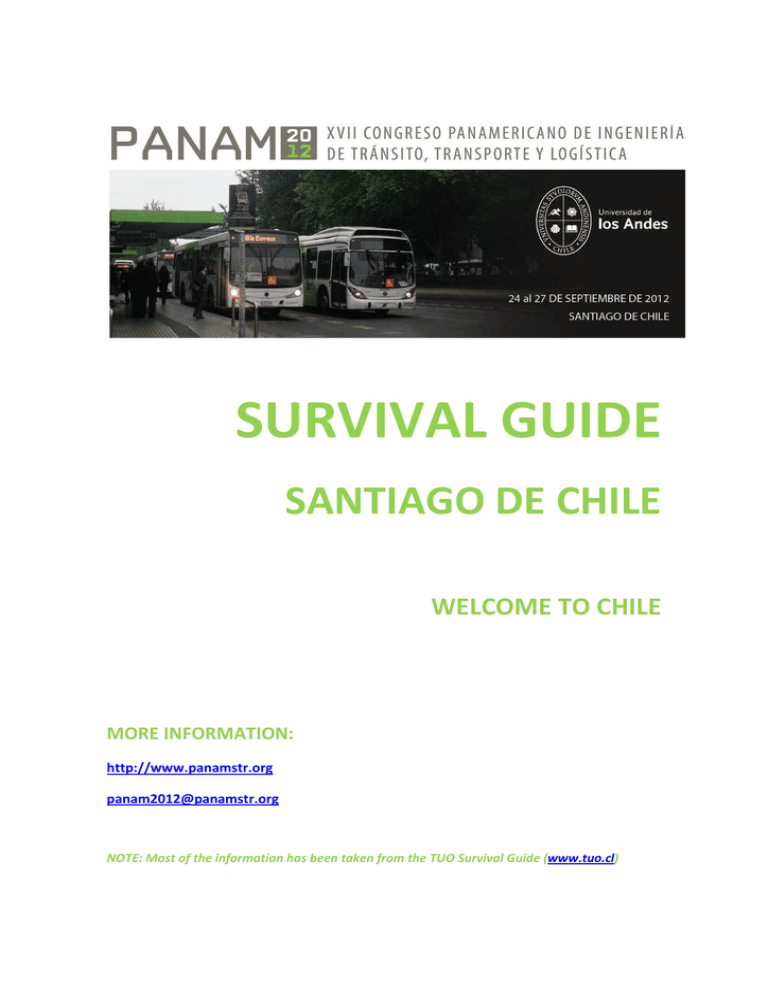
SURVIVAL GUIDE SANTIAGO DE CHILE WELCOME TO CHILE MORE INFORMATION: http://www.panamstr.org panam2012@panamstr.org NOTE: Most of the information has been taken from the TUO Survival Guide (www.tuo.cl) This small guide is intended to make your stay better and to help you move through the city with ease and confidence. Remember to adjust your watch to the local Time Zone: GMT -3:00 (-4:00 from the fourth Saturday of April to the first Saturday of September). 1. Phone Calls The country code for Chile is 56, the city code for Santiago is 2. The telephone numbers are usually 7 digits, 8 for cell phones. For long distance calls, national or international, you need to choose a carrier (a company). Some possible carrier numbers are: 123, 165, 169 and 188. As an example, for a call to Viña del Mar from within Chile you would dial: 165 (carrier) + 32 (code for Viña) + number. To call abroad, 165 (carrier) + 0 (international call) + country code + city code + number. • From cell phones to fixed line, a 0 plus the city code must be added, so a"02" must be placed before the number for Santiago, for instance. • From fixed lines to cell phones, add 09 and then the number (i.e.: 09-12345678). • From cell phone to cell phone you simply dial the cell phone number (i.e.: 12345678). 2. City-Airport-City • Taxi: Expensive, safe and fast. About US$ 30 - 36 for a typical trip. TaxiOficial TaxiVip • Transfer (shuttles): The Transfers Stands are located on the first floor of the Airport (some by the luggage claim) and they are cheaper than the taxis, quite comfortable, but take longer to reach destiny as the trips are shared. Reference cost: US$ 12 - 20 Tur Transfer TransVip • Bus: “Tur Bus” and “Centropuerto” provide a bus service from the Airport to downtown. It’s the cheapest choice, but is not recommended unless you travel lightly and know how to reach your destination from downtown. It will drop you at the “Los Heroes” or “Pajaritos” Metro stations. Reference cost: US$ 4 for a one-way trip, US$ 8 for a roundtrip. TurBus Centropuerto It is always useful to have some Chilean Pesos (CLP) in cash, so it is a good idea to exchange some in the airport. However the money exchange shops in the airport present hardly convenient exchange rates, so probably you want to exchange the bulk of your budget somewhere else (see below). 3. Money Normally, no store or business will accept foreign currency. The best exchange rates are found at the downtown heart, near “Paseo Ahumada” with “Agustinas” corner. There are several money exchange shops in Agustinas. This is near the “Universidad de Chile” Metro station. Never exchange money at the street. ATMs (Automated Teller Machines) are a convenient way to obtain cash in Chile. ATMs are accessible 24 hours at any bank. Many pharmacies, supermarkets and gas stations also have ATMs. They are recognizable by the Redbanc sign. ATMs accept Cirrus, Mastercard and Visa. If you have a foreign account, you can only withdraw money from ATMs. After entering your pin in any ATM machine, choose "foreign accounts" in the bottom left hand corner of the screen. US Dollar exchange rate during the second week of April was about CLP 485 for US$ 1. 4. Getting Around • Bip! Card: For using the public transport (buses and metro) it is absolutely necessary to buy the rechargeable Bip! (pronounced “beep”) Card. It costs CLP$ 1,350 and the minimum charge is CLP$ 1,000. It is highly recommended to charge more than that (about CLP$ 5,000 should be ok), so you don’t have to worry much about it when you go around. You can acquire it at any Metro station and at “Servipag” Stores. • Metro (Subway): Santiago's Metro is the most efficient and fast way to go around the city. It is clean, cheap, frequent and safe, but overcrowded at peak hours. Metro system has 5 lines. For destinations along these lines, it´s quicker than buses. The Line 1 (the red one) is the vertebral column of the Metro system and it runs under Santiago’s main avenue. The Metro operates from 6:00 to 23:00 hrs Monday to Saturday, Sundays and holidays from 8:30 to 22:30 hrs. This schedule varies from one line to another so, if you plan to travel after 22:00 hrs, check the schedule of the Metro lines you will use at: http://www.metro.cl/guiaviajero/horarios (the site is in Spanish). The Metro has a different cost depending on the time of your travel. From 06:00 - 06:30 hrs. and 20:45 - 23:00 hrs., it costs CLP$ 550 per ride. From 06:30 - 07:00 hrs., 09:00 – 18:00, and 20:00 - 20:45 hrs., it costs CLP$ 600 per ride. Between 07:00 - 09:00 hrs. and 18:00 - 20:00 hrs. is the rush hour, so the ride costs CLP$ 660. All these are discounted from your Bip! Card when you enter the platform. Switching between lines has zero cost, and changing from Metro to bus, bus to bus or bus to Metro has usually zero cost too (exception: if you paid $ 550 on Metro, the bus will charge you an additional $ 50). For the cost of one ride, you can take up to 2 different transportation options in a 2 hours lapse. Website: www.metro.cl Metro Lines • Urban Buses: The bus system is called “Transantiago”. It is recommended to visit the Transantiago website in order to plan beforehand. The cost of any trip is CLP$ 580 per ride, which is discounted from your Bip! Card when you enter the bus. You can only enter the buses through the front door and you must bring close your Bip! Card to the recognition yellow machine just in the entrance of the bus until it sounds with a “beep” and the green light shines (if the red one shines and and you hear a triple “beep” then something had gone wrong: try again until it shines green; if it is still not working, maybe you have exhausted all your money in your Bip! Card). Website: www.transportedesantiago.cl (in Spanish only) • Taxis: Taxis are available at all time at Santiago. Taxis are clearly identifiable by their black paint, yellow roof and orange plate. You don’t need to negotiate a price. Pay what the taximeter says at the end of the trip. It is recommended though to ask for an approximation of the trip cost to the desired destiny. Late night fares are normally double the day’s. It is not customary to tip taxi drivers in Chile. Taxi Companies (24/7): o Arauchile: (56 2) 247 30 30 (they have english-speaking service) www.arauchile.cl o Andes Pacífico: (56 2) 204 0530, www.andespacifico.cl • Colectivos: These reasonably-priced group taxis run their fixed routes indicated on the signs on their roofs. They usually wait at the metro stations or at other central locations and leave when there is a minimum of riders. A colectivo can also be stopped anywhere along the way. At night, they will take you to a specific address for an additional fee and as long as it is close to their route (a domicilio). 5. Santiago Santiago is Chile’s capital and one of Latin America’s largest cities. The city sits in a basin, bordered by the Andes Mountains to the east, and the Chilean Coastal mountains on the west. It's a sum of its diverse parts: the colonial structures of central Santiago and Plaza de Armas, the pubs, funky cafes and dance clubs of Bellavista, the Forestal park along Mapocho riverside road; the government office, Palacio de La Moneda, the Mercado Central, a seafood market, and the soulless fenced suburban condos. On a clear day, after the rain has washed out the thick smog layer, from atop Cerro San Cristobal, Santiago's highest hill, you can see the whole city and the not so distant Andes look absolutely astonishing. Two main Tourist Information offices are located in downtown: At Merced street 860, and at Santa Lucia hill; a small in-city hill you should definitely visit. At the hotel they’ll probably be able to give you all the information you need for general tourist activities in Chile. However, it’s worth mentioning that Santiago is about an hour away from good ski centers and about 1.5 hours from the sea and the city of Valparaíso (its centre is World’s Heritage). Excursions to the mountains, vineyards, national reserves and small, nice towns are 1.02.5 hours away. But Chile’s most important tourist attractions are natural landscapes (San Pedro de Atacama, Torres del Paine), which unfortunately are further away, via local flights or long bus trips. The next web pages have English versions: • www.tourismchile.com • www.chilecontact.com • www.sernatur.cl (Government agency for tourism) • www.visitingchile.com • www.visit-chile.org 6. Restaurants Chile has a vast diversity of natural resources, which traduces in a marvelous selection of food choices; these are some restaurants you can visit. Venue Coordinates Specialty/ Typical dish Price (CLP) Style Nolita Isidora Goyenechea 3456, Las Condes, 232 6114 Vitacura 4171, Vitacura, 206 0202 Vitacura 2911, Las Condes, 233 6312 Concha y Toro 34, Santiago Centro, 696 1378 Bulnes 37, Santiago Centro, 681 6109 Constitución 111, Bellavista, 738 0288 Av. 11 de Septiembre 2250, Providencia, 232 1827 Av. Providencia 1373, Luis Thayer Ojeda / 11 de Septiembre Dardignac 195, Bellavista, 732 3902 Domínica 35, Bellavista, 737 1542 El Bosque Norte 210, Las Condes Domeyko 2059, Santiago Centro, 695 1096 San Diego 379-B, Santiago Centro, 699 1309 Italian-American $20,000-$24,000 Modern Seafood, “Merluza Austral” Seafood $14,000-$18,000 Modern $10,000-$15,000 Informal Fusion $18,000-$20,000 Informal/ Romantic Oysters and seafood $10,000-$15,000 Elegant Seafood $17,000-$20,000 Informal Chilean Food $12,000-$18,000 Romantic Chilean Food, “Carne Mechada”, “Plateada” $6,000-$10,000 Informal Chilean Food $15,000-$20,000 Informal Chilean Food $15,000-$20,000 Elegant International $18,000-$25,000 Elegant Chilean Food $6,000-$10,000 Informal Chilean Food $2,000-$6,000 Urban "Picada*" Mira Olas La Sal Zully Ostras Azócar Azul Profundo Giratorio Liguria El Telar El Mesón Nerudiano Enebro Las Delicias de Quirihue El Rincón de los Canallas * “Picada” is an economic place with a very informal approach and great amounts of food. Tipping: A 10% service charge is customary and sometimes included in your bill (not obliged, though). 7. Phone Numbers and Addresses • • • • • Ambulace Urgency Service (24 hours), (56 2) 131 Central Medical Service “Posta Central Doctor Alejandro del Rio”, Portugal 125, (56 2) 6341650 Police (56 2) 133 Firefighters (56 2) 132 Post Office (Correos de Chile) o Plaza de Armas 983 (Central Post Office) o Av. Alameda Libertador Bernardo O'Higgins 3156 local 4 o Av. Manuel Antonio Matta 1034 o Av. Pedro de Valdivia 3499 local 4 8. Other Useful Information • • • • • Warning: Electric power in Chile is 220V. If you plug an electronic device designed for 110V, you’ll burn it. At www.aduana.cl (customs) you can have detailed information on restrictions applicable to goods carried by tourists. Air quality in Santiago is bad; one of the worst in the world. If you have asthma or any other condition related to the respiratory system, you might experience some inconveniences. Just keep your medicines close, and don’t get paranoid; the air won’t kill you. It’s normally safe to walk after dark in Santiago. Take the usual precautions you would take in a 6 million people city. Commercial offices close for a long lunch hour, which can vary from business to business. Generally, hours are Monday through Friday from 10am to 7pm, closing for lunch between 1 and 1:30pm and reopening between 2:30 and 3pm. Most stores are open from 10am to 2pm on Saturday and closed on Sunday. 9. How can I get to the Universidad de Los Andes? The PANAM 2012 will be held at Universidad de Los Andes, Av. San Carlos de Apoquindo 2200, Las Condes, Santiago, Chile. The university is located in the northeast side of Santiago, 20 minutes from “Hernando de Magallanes” Subway station (please see the map below, A is Universidad de Los Andes and M is Subway). To get at Universidad de Los Andes, you have three options: • Metro + Taxi or Colectivo: you can travel by metro (Line 1 “Red Line”) to Hernando de Magallanes Subway station and then take the colectivo Nº 1003 or any taxi to the university • Metro + Bus (Transantiago): you can to travel by metro (Line 1 “Red Line”) to Los Dominicos Subway station and then take the urban bus C-02c (Transantiago) to the university. • Free Buses: the university will offer a free system of buses from the Hernando de Magallanes Subway station (Line 1 “Red Line”) to/from the university. If you would like to use this buses you must register first by sending your full name to panam2012@panamstr.org The 100-acre campus combines modern infrastructure with green areas. For the Congress you must get directly to the Library Building (please see the map below, 4 is Library Building). Please see more information at www.panamstr.org / www.uandes.cl Main entrance Library Building Gym Humanities Building El Reloj Building Soccer field Science Building ESE - Business School Future Clinic U. de los Andes

